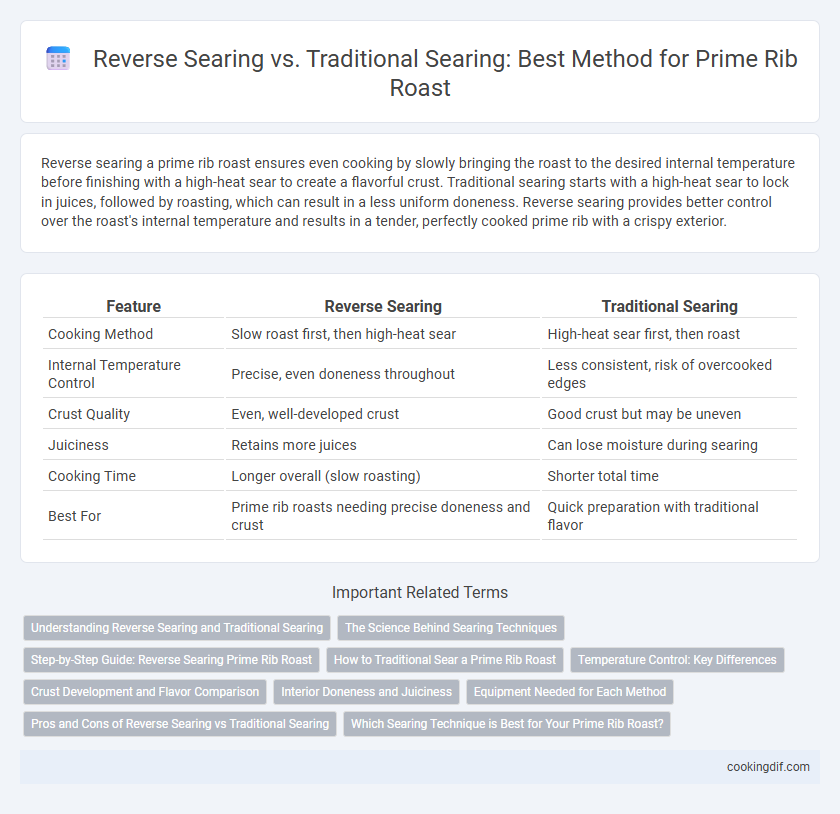Reverse searing a prime rib roast ensures even cooking by slowly bringing the roast to the desired internal temperature before finishing with a high-heat sear to create a flavorful crust. Traditional searing starts with a high-heat sear to lock in juices, followed by roasting, which can result in a less uniform doneness. Reverse searing provides better control over the roast's internal temperature and results in a tender, perfectly cooked prime rib with a crispy exterior.
Table of Comparison
| Feature | Reverse Searing | Traditional Searing |
|---|---|---|
| Cooking Method | Slow roast first, then high-heat sear | High-heat sear first, then roast |
| Internal Temperature Control | Precise, even doneness throughout | Less consistent, risk of overcooked edges |
| Crust Quality | Even, well-developed crust | Good crust but may be uneven |
| Juiciness | Retains more juices | Can lose moisture during searing |
| Cooking Time | Longer overall (slow roasting) | Shorter total time |
| Best For | Prime rib roasts needing precise doneness and crust | Quick preparation with traditional flavor |
Understanding Reverse Searing and Traditional Searing
Reverse searing involves slowly roasting the prime rib at a low temperature before finishing with a high-heat sear to develop a flavorful crust, ensuring even doneness throughout. Traditional searing starts by applying intense heat to the meat's surface to create a browned exterior followed by roasting, which can sometimes result in a less uniform internal temperature. Understanding these methods highlights how reverse searing provides precise temperature control while traditional searing emphasizes rapid crust formation.
The Science Behind Searing Techniques
Reverse searing prime rib roast involves slowly cooking the meat at a low temperature before finishing with high heat, allowing even heat distribution and better moisture retention. Traditional searing starts with high heat to form a Maillard reaction crust, which enhances flavor but can cause uneven cooking and moisture loss. The science behind these techniques centers on balancing the Maillard reaction's flavor development with moisture preservation to achieve a tender, juicy roast.
Step-by-Step Guide: Reverse Searing Prime Rib Roast
Begin by seasoning the prime rib roast generously and roasting it at a low temperature of 225degF until the internal temperature reaches 120degF for medium-rare doneness. Remove the roast from the oven and let it rest for at least 20 minutes to allow juices to redistribute. Finally, sear the roast in a hot cast-iron skillet or grill for 2-3 minutes per side to develop a flavorful, caramelized crust.
How to Traditional Sear a Prime Rib Roast
To traditional sear a prime rib roast, start by patting the meat dry and seasoning it generously with salt, pepper, and aromatics. Heat a heavy skillet or roasting pan over high heat until smoking, then sear the roast on all sides for 2-3 minutes per side to develop a deep, flavorful crust. After searing, transfer the roast to a preheated oven to finish cooking to the desired internal temperature, ensuring even doneness and a tender, juicy interior.
Temperature Control: Key Differences
Reverse searing for prime rib roast involves slow-cooking the meat at a low temperature before searing, allowing precise internal temperature control and even doneness throughout the roast. Traditional searing starts with high heat to create a crust, which can lead to temperature gradients and less consistent cooking inside the prime rib. The key difference lies in reverse searing's ability to maintain gradual heat increments, minimizing the risk of overcooking while achieving a tender, juicy prime rib.
Crust Development and Flavor Comparison
Reverse searing Prime Rib Roast enhances crust development by slowly rendering the fat and allowing the surface to dry, creating a deeply caramelized and evenly browned exterior. Traditional searing often produces a faster, more intense crust but can risk uneven cooking and potential overcooking near the edges. Flavor comparison reveals reverse searing provides a richer, more uniform beef flavor with superior juiciness, while traditional methods emphasize a pronounced, slightly charred crust flavor.
Interior Doneness and Juiciness
Reverse searing prime rib roast ensures consistent interior doneness by slowly bringing the meat to the desired temperature, resulting in evenly cooked, tender slices. Traditional searing often causes a gradient of doneness, with a well-done crust and a less evenly cooked interior. The reverse sear method enhances juiciness by allowing the fat to render gradually, preserving moisture throughout the roast.
Equipment Needed for Each Method
Reverse searing prime rib roast requires an oven or smoker to slowly bring the meat to the desired internal temperature before a quick sear using a cast iron skillet or grill. Traditional searing demands a heavy-duty pan or grill for an initial high-heat sear, followed by transferring the roast to an oven for cooking. Both methods benefit from a reliable meat thermometer to ensure precise doneness.
Pros and Cons of Reverse Searing vs Traditional Searing
Reverse searing prime rib roast offers precise temperature control and even cooking, reducing the risk of overcooked edges while achieving a uniformly pink interior. Traditional searing locks in juices quickly with high heat, creating a strong crust but may result in uneven doneness and a less tender roast. While reverse searing requires longer cooking times and careful temperature monitoring, traditional searing delivers faster results but with potential for overcooked or dry outer layers.
Which Searing Technique is Best for Your Prime Rib Roast?
Reverse searing offers more even cooking and better control over internal temperature, making it ideal for prime rib roast to achieve a perfect medium-rare center with a consistent crust. Traditional searing, performed before roasting, creates a flavorful exterior but can lead to uneven doneness and tougher edges. For prime rib roast, reverse searing is generally preferred because it enhances tenderness and delivers a more uniform cook throughout the meat.
Reverse Searing vs Traditional Searing for Prime Rib Roast Infographic

 cookingdif.com
cookingdif.com